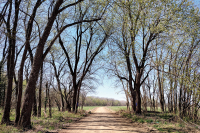Legacy of a mountain family
For 75 years, Cataloochee Ranch has been serving up a taste of the Wild West in the Smokies.
From its mile-high perch on Fie Top Mountain, the ranch offers respite and solitude, fishing and horseback riding, expansive rolling meadows and prized vistas.
But courting a metropolitan clientele to Cataloochee Ranch in its early days wasn’t easy. The Ranch was isolated and rugged, a wind-swept mountain outpost where bears preyed on sheep and moonshiners guarded their secret stills.
The founders, Tom and Judy Alexander, were city transplants from elite social circles, Tom as the son of a judge from Atlanta and Judy as the daughter of a doctor in Richmond, Va.. But Tom’s dashing ingenuity and Miss Judy’s fabled charm convinced locals to lend a hand to the new-fangled tourism venture. Their joy for life was so addictive that a strong and loyal following of guests was clinched nearly on that charisma alone.
The couple thrived in their adapted home. Tom was soon wrangling cattle and orchestrating muzzle-loading rifle matches. Miss Judy learned to salt hams and make jellies, but played an equal role in tending the Ranch, even fending off bears that found their way into the smoke house. She once sauntered through the Ranch house with a dead bobcat over her shoulder, surprising guests who were kept guessing about its origins.
The two met in the mountains after following different paths here.
Miss Judy came to Asheville for boarding school and entered the flapper scene of the Roaring ‘20s. Meanwhile, Tom, a forester by profession, was working in the region for a private timber estimator. Tasked with appraising the value of timber in the soon-to-be-created Great Smoky Mountains National Park, his job took him roaming through the high mountains where he came into his own as a rugged outdoorsman.
When the Depression hit, coinciding with the demise of the logging era, Tom’s employer went bankrupt and paid him out with company equipment, including tents, a chuck wagon and sundry backcountry gear.
With no other prospects for work on the horizon, Tom opened a tourist fishing camp in the Smokies’ hinterlands, catering to some of the new national park’s first visitors in 1931 and 1932. But the Three Forks camp was remote and inaccessible, and the park service, recognizing the value in providing amenities to visitors, encouraged him to shift the operations to Cataloochee Valley.
Miss Judy, just 24 at the time, joined him in the venture, taking up residence among mountain families still living off the land in the isolated valley. They were adopted by the community, in part thanks to the black medical bag Miss Judy’s father had given her to care for basic ailments.
“Word spread up and down the valley that Miss Judy had all this doctoring stuff,” recounted Alice Aumen, a daughter of Tom and Miss Judy who was an infant during those years.
Tom soon tired of the park’s arduous rule book, however. They couldn’t hunt, couldn’t cut trees, couldn’t build a new fence or guest cabins without permission. When the park told him his beloved dog, Foxie, who loyally accompanied the guests on backcountry horse trips, would have to be leashed, he drew the line.
“My dad said ‘He’s never has been on a leash and he never will be,’” Tom’s daughter Judy Coker recalled. “He told us that was the straw that broke the camel’s back.”
Tom began scouting for new land outside the park’s borders and purchased 1,000 acres on Fie Top mountain above the then-rural community of Maggie Valley.
The mountaintop land, which had previously belonged to a rugged farmer and rancher, consisted of a derelict collection of outbuildings and barns. The task of transforming the property into an appealing resort was arduous to say the least. But Tom and Miss Judy quickly found a willing workforce of mountaineers with few other prospects for cash money.
The Ranch provided work to scores of locals as horse wranglers, cooks, dish washers, hunting guides, farmers, and even fiddlers to entertain guests. They raised sheep and cattle, and grew much of the food that was served up to guests. And they always seemed to have a good supply of moonshine on hand, which was fondly sampled by many of the Ranch guests.
While outsiders, particularly affluent ones, were often viewed skeptically and kept at arms’ length by locals, Tom and Judy Alexander were embraced. They were already well-versed in mountain ways from their years in Cataloochee Valley and held the mountain people in high regard.
“My dad was such an every man. He formed friendships with every kind of person you could imagine, from big time corporate executives all the way down. The people who worked for him all loved him,” Aumen said.
Nonetheless, they maintained their more elite social lives, mingling with the upper classes of Waynesville and the Biltmore circles in Asheville. The Ranch’s guests were affluent and metropolitan, providing Tom and Judy with an endless stream of entertainment.
“They made such close friends among the guests that they were always traveling to visit in the winter months,” Aumen said.
The operation of Cataloochee Ranch more often than not fell to Miss Judy. Tom, a forester by profession, held steady jobs off the mountain, first with the forest service and later as a timber appraiser for Champion Paper Mill in Canton.
A world apart
Growing up at the Ranch was an idyllic childhood for the Alexander children, Alice Aumen, Judy Coker, and a son, Tom Alexander, Jr.
“From the age of five or six, mother never knew where we were,” Aumen said.
While they attended boarding school in Waynesville and Asheville during the week — due to bad roads that kept the mountaintop isolated — summer and weekends were spent roaming the rolling meadows, riding horses and playing with the children of guests. Visiting families stayed for weeks at a time, and often returned year after year.
“It was very much an extended family,” Aumen said of the guests.
The road to the top of the mountains was once impassible for much of the winter. Miss Judy, when staying on the mountain alone with Tom at work and the children in boarding school, used a signal system with a lantern to indicate when she got stranded.
Guests driving to the Ranch relied on roadside sign posts instructing them to shift to a lower gear or cool their engine, warning them of particularly treacherous switchbacks ahead. One even declared: “If car chatters on rocks, reduce air pressure in rear tires.”
The early isolation meant Alice and Judy grew up with one foot in two worlds. During the summer and weekends, they were barefoot mountain girls. During the week, they were city girls, attending boarding school in Waynesville, and for some years in Asheville.
For high school, the girls attended St. Catherine’s in Richmond. After that, it was on to Duke University.
Tom and Judy wanted the best schools, but couldn’t afford it on the Ranch’s income alone.
“We went to pretty high dollar schools,” Judy said.
Aumen said her parents never spoke a word about the price of their education.
Taking the reigns
Alice and Judy didn’t initially set out to operate the Ranch in their parent’s footsteps. Judy followed her husband to South Carolina, while Alice went off to design school in New York, then moved to San Francisco. Tom Jr. was busy pursing a career in journalism.
But in the early 1960s, Judy’s husband grew tired of working in his family company in South Carolina and suggested they move back to the Ranch. Judy gladly complied. Alice was back home from San Francisco visiting for a couple weeks and was caught up in the excitement of a new venture: opening the first ski area in North Carolina.
“I said ‘Oh this sounds like fun,’ and I never went back,” Alice said.
Tom had long toyed with the idea of starting a ski operation. In the 1940s, Miss Judy and the kids would strap on homemade skis — made from bent wood and leather straps — and go careening down the mountain. But a ski slope for tourists proved out of the question until the advent of snow-making technology.
Tom was driven to open a ski area in hopes of providing steady employment for local people and creating a wintertime tourism economy for Maggie Valley. He had, after all, always been concerned with the welfare of the local people.
“He also liked any kind of challenge. He was somewhat of a visionary you could say,” Aumen said. “It was something new and no one was doing it.”
Tom was surely pleased about the return of both daughters but didn’t show it.
“Dad just said ‘Good, now I’ve got help. We’ll start the ski area,’” Judy recalled.
The previous year, Tom and Miss Judy contemplated selling off the Ranch. But the daughters’ return to the mountaintop set the stage for a continuing family legacy.
It would be several more years, however, until Aumen met her future husband, Tom. It’s hard to imagine a better first impression than the one pulled off by Tom Aumen, who made an uninvited helicopter landing in the middle of the Ranch one Sunday morning. He’d just opened a helicopter sightseeing service in Maggie Valley and popped in for a look-see of the Ranch during some down time.
Tom Alexander was infatuated with helicopters and invited the young man to stay for lunch. Aumen married him shortly thereafter.
The two daughters and their husbands, along with Tom and Miss Judy, embarked on the all-consuming project of opening a ski area, installing rope tows and snow making equipment on one of the mountain’s slopes.
Cataloochee Ski Area became a booming business in its own right. It was eventually sold by the family and operates as an independent company today.
Finding their niche
While some family businesses are fraught with internal conflicts and divergent visions, everyone found their own niche when it came to running the Ranch. Luckily, the two sisters, Judy and Alice, have quite different interests. For Judy, her love was being in the barn with the horses and roaming the property.
Alice became the office manager, running the reservations desk and bookkeeping. During the early years in the ski business, she even ran a retail shop in Atlanta selling ski merchandise. And her flair for interior design has certainly found an outlet, adding new elements to the cabins and ranch house as needed, although the rustic antique decor has changed surprisingly little.
Today, she still arranges flower vases for the guest cabins and tables, artfully weaving in native plants like the waxy green leaves of Galax.
Judy, who always gravitated toward the barn as a girl, found a home among the backcountry horse guides, accompanying the expeditions to tend to the horses and help cook camp meals.
“Judy wouldn’t be caught dead arranging flowers,” Alice said of her sister.
“That’s not so,” Judy protested, but then thought better of it.
Judy admits she would much rather be on her hands and knees in the meadow, repairing divots in the earth torn up by destructive wild hogs. Judy can still be found fixing fences and trapping nuisance hogs, announcing four killed last week. She spends less time in the barn and with the horses, a job that now falls to her daughter, Judy B., as stable manager.
Passing it on
Another changing of the guard is underway at Cataloochee Ranch. While Judy’s daughter, Judy B., tends to the Ranch’s prized herd of horses, Alice’s son, Alex, has taken on the role of general manager.
Alex didn’t set out to carry on the family legacy at Cataloochee Ranch, but a suspicion it may be in the cards steered him towards a business major in college.
“When you are 20 or 21, you have no clue. You say ‘Well that would be handy one day if you go back to the Ranch,’” said Alex, 40.
Technically his first jobs at the Ranch were as a child, whether it was cleaning horse stalls, mowing the grass or washing dishes. But most of his childhood memories are of the pure and complete freedom the remote mountaintop afforded — coupled with a revolving door of visitors who kept it exciting.
“You had an endless stream of playmates all summer long. It was like growing up at a summer camp,” Alex said.
He still keeps in touch with a few summer playmates who vacationed at the Ranch, some who have homes in Haywood County today and others who now bring their own children to family vacations at the Ranch.
Alex’s wife, Ashli, also works at the Ranch, overseeing food service. She plans menus, cooks meals, shops for the food, manages wait staff, and pitches in with accounting.
Waiting in the wings
Navigating the Ranch into the 21st century has been a balancing act, refining the operations just enough to meet the expectations of upscale travelers while retaining its historic character.
“Expectations of our travelers have changed,” Alex said. “People want to feel like they are in a rustic setting but still want their amenities. They want to be in the middle of nowhere but still check their email.”
Historic photos of the Ranch show visitors pitching in to split wood. They survived without hot water and relative isolation during their stay. Today, the Ranch has wireless Internet, and added satellite TV to the cabins last year.
But the spirit of Cataloochee Ranch has changed surprisingly little.
The furniture in the ranch house is still pushed back for Saturday night square dances. Guests are still greeted by the smell of a wood fire and the creak of wooden floor boards when they step onto the porch of the Ranch house. Inside, farm implements hang on the walls, quilts drape over the banisters and antiques comprise most of the furniture, save the Western-style leather sofas added for comfort’s sake.
The long-range views are still everywhere you look — the expansive meadows crowned by distant ridgelines, the world unfurling below you from the vantage of an Appalachian mesa.
“People say it’s changed, but it is still Cataloochee,” Alex said.
Another constant has been the menu, with many of the old recipes created by Miss Judy still served up during the fabled breakfasts and dinners at long banquet tables.
“There are people who come back and request things they had as children here, onion casserole being the number one,” Alex said.
Families retreat to the Ranch today to reconnect: with the outdoors, with a simpler time and with each other. Meals as a family are in itself a novelty.
“Statistically, most people don’t sit down as a family and eat together anymore,” Alex said. “An appeal for families now is that it reminds them of when they were kids. Today, you can’t just turn your kids out to play and not worry about them every second. Here as soon as they eat, they are gone playing outside. You don’t ever have to get back in your car once you are here.”
The Ranch has expanded guest quarters and cabins, accommodating twice as many people as it used to. Today a full house is 70 people.
Running a bigger operation requires a more structured work flow, with duties spelled out in job descriptions and schedules for when to do what, unlike the old days when many employees were live-ins or neighboring locals who constantly tended to affairs of the Ranch, whether it was their shift or not.
The ranch has 25 to 30 full-time employees during the peak season, dropping back drastically in winter when it shuts down all together. Even the horses go on winter sabbatical, with many of them boarded in South Carolina and brought back again in the spring.
Today, Alex’s and Judy B.’s own children are growing up at the Ranch, marking the third generation to spend its childhood roaming the high meadows and socializing with out of town guests.
The Ranch is less isolated with each generation. A school bus now comes to the top of the mountain to fetch the children daily. Last week, Alex could easily pop into town for a midday Thanksgiving program at his daughter’s school. She plays softball and is integrated into the community in ways he never was — let alone the generation before him.
Only time will tell if the fourth generation will eventually continue tradition and run Cataloochee Ranch.
“The only thing you can do is cross your fingers and expose them to it as much as you can,” Coker said. “They have to get their education go out into the world and then make their decision.”













